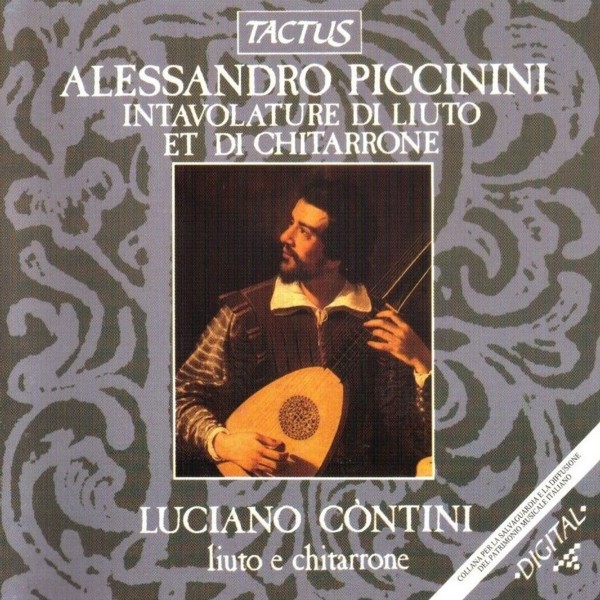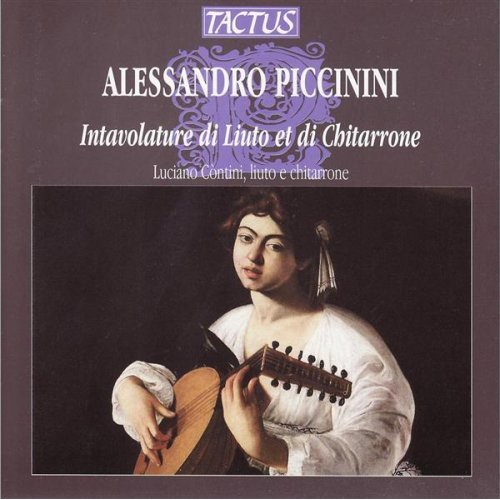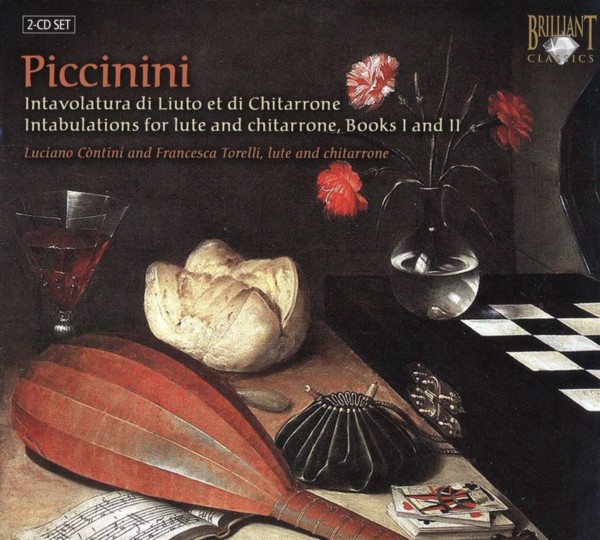
amazon.com
Tactus TC 56160101
mayo & julio de 1988
Eremo di Ronzano, Bologna

amazon.com
Tactus TC 56160101
mayo & julio de 1988
Eremo di Ronzano, Bologna
Alessandro PICCININI
(1566-1639)
Intavolature di Liuto et di Chitarrone. Libro Primo, Bologna 1623
Intavolatura del Chitarrone
01 - Toccata IIII [1:19]
02 - Corrente III [0:51]
03 - Partite variate sopra la Folia aria Romanesca [1:51]
Intavolatura da Liuto
04 - Passacagli [4:28]
05 - Corrente X [1:06]
Intavolatura del Chitarrone
06 - Toccata III cromatica [3:44]
07 - Partite variate sopra quest'aria francese detta l'Alemana
[4:45]
08 - Corrente VI sopra l'Alemana [1:02]
Intavolatura da Liuto
09 - Toccata IIII [2:36]
10 - Aria IIII [2:31]
11 - Gagliarda XI [1:57]
Intavolatura del Chitarrone
12 - Toccata XII [2:15]
13 - Corrente IIII [1:29]
14 - Corrente V [1:27]
Intavolatura da Liuto
15 - Toccata II [3:40]
16 - Aria I affettuosa [3:53]
Intavolatura del Chitarrone
17 - Toccata VI [2:30]
18 - Corrente I [1:04]
19 - Corrente II [1:10]
Intavolatura da Liuto
20 - Toccata cromatica XII [2:57]
21 - Corrente III [0:40]
22 - Corrente VI [1:16]
Intavolatura del Chitarrone
23 - Toccata X [2:37]
24 - Corrente X [1:01]
25 - Gagliarda III [1:08]
Luciano Còntini, liuto & chitarrone

«The music for lute by my father, Alessandro Piccinini,
whether for its merit or for its good fortune, was met with favor
in the world while he was alive...»: with these words,
Leonardo Maria Piccinini modestly justifies his decision in 1639 to
publish a posthumous collection of pieces for lute by his father. And
yet only ten years previously, Alessandro, while still living, was
referred to as «unequaled in the playing of the lute» by
his countryman Adriano Banchieri.
The best known and most authoritative member of a Bolognese family
which had produced musicians for at least three generations. Alessandro
was born on 30 January 1566, son of Leonardo Maria, himself a lutenist,
as was very probably his father before him. Since the most recent
biographical dictionaries are incomplete and inexact with regard to the
Piccinini family, let us list the most significant facts in light of
partially unpublished documents: Leonardo Maria (I) had, in addition to
Alessandro, numerous children among whom at least two others were also
lute virtuosos: Girolamo, who was born in 1573 and died in Flanders in
1610 (and not in 1615 as was earlier believed) and Filippo (1575-1648).
Leonardo Maria I, after having declined the position offered to
Alessandro at the Mantuan court (since «he would have been unable
to train and instruct his sister and younger brothers as he did for two
or three hours a day»), took the entire family with him to
Ferrara where, beginning in 1582, he and his three lutenist sons appear
on the employment lists of the munificent court of Alfonso II d'Este.
According to Newcomb, Leonardo died sometime before January 1597, a
theory supported by the fact that in that same year the first official
receipts for Girolamo and Filippo are recorded. The role of the
Piccinini family at the Estense court seems to be more closely tied to
the duke's private entertainments than to public festivities, aside
from special duties regarding experimentation in organology which will
be discussed below. Following the death of Alfonso II and the passing
of Ferrara to the papal states (1598), the Piccinini brothers were,
together with the famous Luzzaschi, the only musicians from the
flourishing Estense chapel to be hired by Cardinal Pietro Aldobrandini,
nephew of Pope Clement VIII and the most important of Ferrara's new
governors. The cardinal's new arrangements in his Roman apartments
provided the three lutenists with an entry into a dynamic and open
musical and cultural environment. Claudio Annibaldi has carefully
documented this period wich marks the beginning of the brother's
separation: for some years now they had together provided entertainment
for the Roman evenings of two Ferrarese brothers destined to notoriety:
Guido, the future cardinal, and the marquis Enzo, Ferrarese ambassador
to Rome from 1608 to 1611. From the year 1608, Girolamo Piccinini had
even become a sort of administrator and tutor to the young Guido on his
arrival in Rome, accompanying him on this first important mission as
nuncio in Flanders, while Alessandro had moved on officially to the
house of the Bentivoglio, together with the celebrated Frescobaldi,
following the arrival of the marquis in Rome in 1608. In addition to
numerous letters, the dedication to Cardinal Guido in the volume edited
by Alessandro's son in 1639 testifies to the familiarity of the three
musicians with the Bentivoglio family.
Filippo having departed, first for the court in Turin and then for
Madrid (where he was employed in the real capilla as the only
lutenist from 1616 until at least 1637), and Girolamo having died while
in the service of Cardinal Guido, Alessandro now chose not to follow
the marquis Enzo back to Ferrara in 1611, but rather to return to
Bologna with his wife Cornelia whom he had married in Rome. (In a
letter of the same year, he writes to Bentivoglio: «and if my
wife had not still been somewhat ill, I would have come to Ferrara in
place of my brother»). After this time, the correspondence
between Alessandro and the Bentivoglio family remains, for at least a
decade, quite intense but completely lacking in artistic references,
demonstrating instead a surprising interest on the part of the
Bolognese musician in wine commerce or small business affairs. His
brother Paolo and his son Leonardo Maria II (who died in 1645) probably
maintained more direct artistic ties with Ferrara. Alessandro's death
must have occurred before December 1638, as a letter by the Bolognese
painter Domenichino reveals.
The most important documentation regarding the compositions of
Alessandro (with the exception of a madrigal by Filippo, no other works
by the brothers have survived) is to be found his Intavoiatura di
liuto, et di chitarrone. Libro primo, published in Bologna by the
heirs of C.P Moscatelli in 1623. Other compositions bv Alessandro
appeared posthumously in the above-mentioned 1639 collection edited by
his son Leonardo Maria. (In this collection there is no distinction
made between the works by the father and those of the son also included
in the book, though at least two sources in manuscript seem to present
unpublished compositions by Alessandro, indicated by the sign
«AP»). Information regarding the origin, of the 1623
collection was based until recently upon a letter of that year by
Alessandro himself in which he urged the cardinal d'Este of Modena to
intevene on behalf of this first book of intabulations, the publication
of which had been interrupted by the death of the printer. An
unpublished letter from the previous year reveals a working
relationship between the same cardinal, in the role of teacher, and a
young unnamed lutenist. And still earlier, in 1614, Alessandro confided
to the marquis Bentivoglio his intention of printing a book of music:
"I have begun an undertaking, namely, to have engraved a book (of
music) to be played on the lute which I already began to write in Rome;
it will be quite an expense to print, but I have no doubt that I shall
earn from it."
The 1623 collection, as well as the other sources cited (aside from the
manuscripts, which contain the dance stereotypes most in vogue among
amateurs), includes the forms of instrumental music most often used in
the first decades of the seventeenth century by professional musicians:
above all toccate, correnti and gagliarde, forms
thoroughly developed and enlivened by masters of the keyboard such as
Frescobaldi and the Neapolitans, by harpists, and by lutenists such as
Kapsberger and Melii. The style of Piccinini seems in comparison to be
somewhat conservative, and one often has the impression that many of
the compositions date back perhaps to earlier decades, although
presented here in a revised version. The composer's expertise is
revealed in pieces such as the chromatic toccatas (the third for
chitarrone, the twelfth for lute) and in partite
«variate» - an homage to the Roman (and Neapolitan)
styles most in vogue in those years. Of great importance is also
the introductory section whose 33 chapters constitute an authentic
tutor for playing the lute, including basic indications regarding
performance practice ("Playing loud and soft", "How to play arpeggios",
etc.) and organology. Moreover, until recently Piccinini's fame was due
primarily to these latter indications, albeit resulting in serious
misunderstandings
The role played by Alessandro in the creation of the new
«longbodied» lutes (di corpo longo), the first
experimental models of which were built around 1594-96 in Venetian
workshops for Duke Alfonso II, is in fact well noted. As Orlando
Cristoforetti has correctly pointed out, Alessandro never boasted of
having invented the theorbo or the chitarrone (which seems instead to
have originated at the Florentine courts), but only of having first
come up with the idea of lengthening the neck for low strings, thus
transforming the lute into an «arch-lute» and leading
somehow to a similar configurations in the chitarrone (which is
distinguished by having the first two strings tuned an octave lower
than those of the lute). Crisioforetti's ideas are confirmed by the
above-mentioned letter of 1614 from Picrcinini to the marquis
Bentivoglio in which he writes: «If the corrento that
Your Illustrious Lordship desires were for the lute, I would already
have sent them to you, but I have never done anything on the theorbo
except for certain little things taken for sport from the lute,
((pieces)) which everyone has in Ferrara». It is probable that
the Roman fashion begun by Kapsberger had an effect on the later
decision also to include music for the theorbo in the 1623 publication,
while the posthumous book of 1639 is only for lute.
While musicological research has finally dismantled the belief
according to which the art of lute playing disappeared with the onset
of the 17th century, the increasing use of historical intruments in
modern performances has at the same time restored to Alessandro
Piccinini, unjustley considered the «last lutenist»
(Vatielli), his place as one of the great composers of his time.
Dinko Fabris
(Translation: Candace Smith)
compilado junto con el Libro Secondo en interpretación de
Francesca Torelli en Brilliant Classics 93353:
